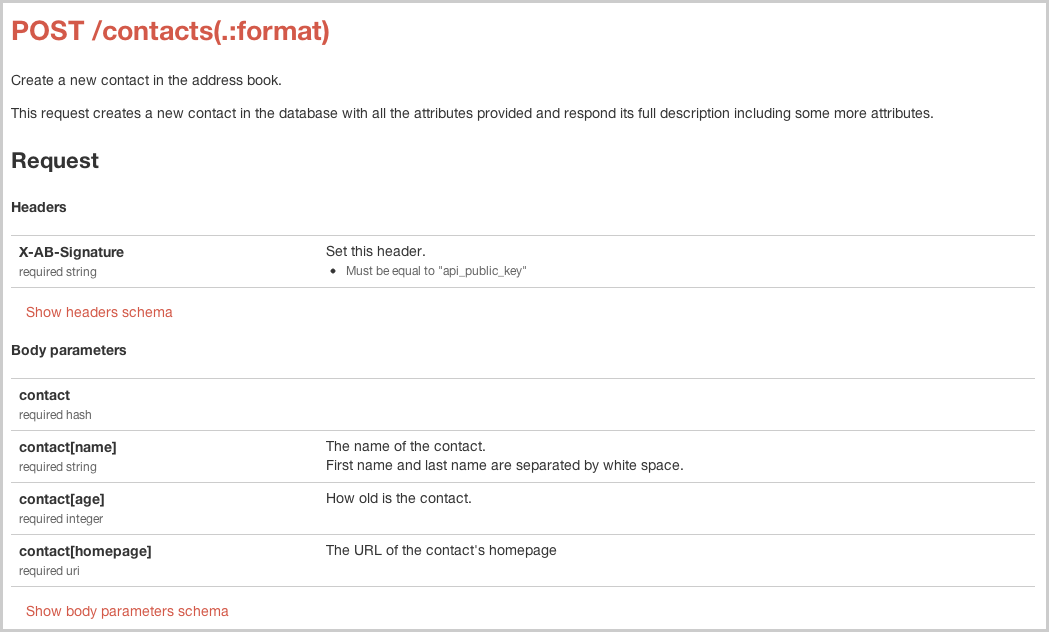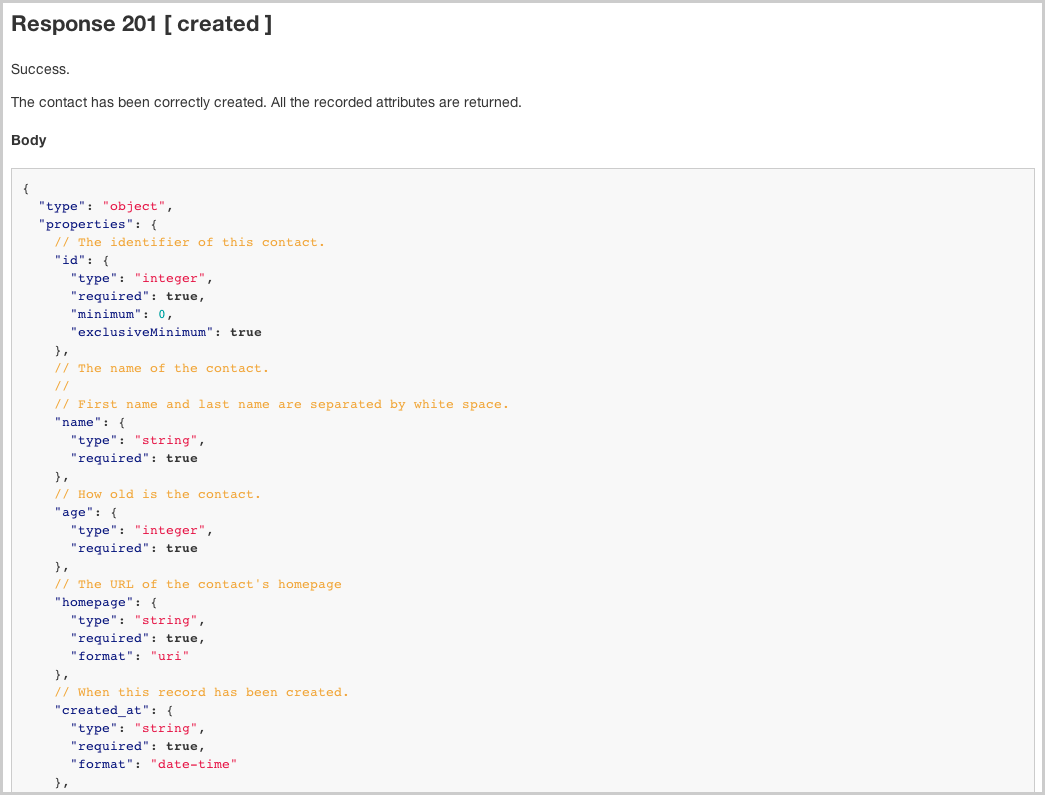Respect plugin for Rails
Respect for Rails lets you write the documentation of your REST API using Ruby code. Your app's API is published using a Rails engine so it is always deployed along with your application and stays synchronized. A filter is available so you can also easily validate requests and responses. Thanks to that your incoming parameters will also be sanitized so if you expect a URI in a parameter value you will get a URI object instead of a string object containing a URI. It follows Rails DRY principle and save you a lot of typing since it fetches most of the information automatically by inspecting your routes, their constraints and your model validators. You can always adjust the default by defining the schema per resource and/or controller.
Features
- A compact DSL from the Respect gem to specify your REST API documentation.
- Filters to automatically validate and sanitize incoming parameters.
- A Rails engine to serve your public REST API documentation.
See the RELEASE_NOTES file for detailed feature listing.
Take a tour
This section guides you for a walk around the main features available.
Document an action request
Respect for Rails lets you easily describe the structure of incoming requests and outgoing responses
using a simple and compact Ruby DSL. Assuming you have the scaffold of a ContactsController, the structure
for its create action may look like this:
# in app/controllers/contacts_controller.rb
# POST /contacts
# POST /contacts.json
def_action_schema :create do |a|
a.documentation "Create a new contact in the address book."
a.request do |r|
r.body_parameters do |s|
# They look like something like that:
# { contact: { name: "Albert", age: 62, homepage: "http://example.org" } }
s.hash "contact" do |s|
s.string "name", doc: "The name of the contact."
s.integer "age", doc: "How old is the contact."
s.uri "homepage", doc: "The URL of the contact's homepage"
end
end
end
end
def create
# ...
end
The def_action_schema macro only defines a create_schema method in your controller.
Note that we distinguish from where the parameters come from (path, query or body) for the sake of documentation.
To see the generated doc, you must mount the provided engine like this:
# in config/routes.rb
mount Respect::Rails::Engine => "/rest_spec"
Now if you point your favorite web browser to http://localhost:3000/rest_spec. You should see something like that

Document an action response
When documenting an API it is also important to write how the response will look like. You can add this code to specify the body of the response when the status is "created":
# in app/controllers/contacts_controller.rb
# in def_action_schema :create block
a.response_for do |status|
status.created do |r|
r.body do |s|
s.integer name, greater_than: 0, doc: "The identifier of this contact."
s.string "name", doc: "The name of the contact."
s.integer "age", doc: "How old is the contact."
s.uri "homepage", doc: "The URL of the contact's homepage"
s.datetime "created_at", doc: "When this record has been created."
s.datetime "updated_at", doc: "When this record has been updated lastly."
end
end
end
The generated documentation would look like that:

The specification standard used to document schema is defined at json-schema.org (we currenly follow draft v3).
Factor specification code
As you have probably noticed there is some repetition in this code. To avoid that you can create an helper like this:
# in app/helpers/respect/application_macros.rb
module Respect
module ApplicationMacros
def id(name = "id")
integer name, greater_than: 0
end
def contact_attributes
string "name", doc: "The name of the contact."
integer "age", doc: "How old is the contact."
uri "homepage", doc: "The URL of the contact's homepage"
end
def contact
id
contact_attributes
end
def
doc "When this record has been created."
datetime "created_at"
doc "When this record has been updated lastly."
datetime "updated_at"
end
end
end
Notice that we have also provided a macro for the usual id attribute. This helper must be installed in the
schema definition DSL like that:
# in config/initializers/respect.rb
Respect::Rails.setup do |config|
config.helpers Respect::ApplicationMacros
end
Now the request schema can be rewritten like this:
r.body_parameters do |s|
s.hash "contact" do |s|
s.contact_attributes
end
end
and the response schema like that:
r.body do |s|
s.contact
end
Validate requests and response
All the information you have included in the action specification can also be used to drive a
validation process. To enable it you just have to install an "around" filter in your
ApplicationController like this:
around_filter :validate_schemas!
Responses formatted in JSON are validated only in development and test mode.
When validation failed an exception is raised. To help you debug, we provide a more specific
view than the usual exception reporting view of Rails. You can install this view by adding the
following line to your ApplicationController:
rescue_from_request_validation_error if Rails.env.development?
Sanitize your incoming parameters
Incoming request parameters must often be sanitized since they come from un-trusted users.
A sanitized version of the request parameters is built along the validation process and stored
in the request object. You can access it using request.sane_params. Sanitized object
may have a more specific type than the original parameter value. For instance the homepage
parameter will be a URI object instead of String object:
request.sane_params[:contact][:homepage].class #=> URI::Generic
You can also automatically sanitize the request parameters in-place by installing this "before" filter:
before_filter :sanitize_params!
Headers documentation
Often REST APIs expect headers to be set in the request and/or responses.
Respect for Rails lets you document that using the headers statement available for both
the request and the response.
a.request do |r|
r.headers do |h|
h.doc "Set this header."
h['X-AB-Signature'] = "api_public_key"
end
end
Documentation string
The DSL lets you write documentation string at many places. All these strings are structured with a title
on the first line followed by an empty line and a description for the rest of the string. It is much
like git commit messages expect that if there is only one paragraph the title will be omit. You can set
the documentation like this for most of the items using the doc statement or the :doc option when
available. See this example:
doc <<-EOS.strip_heredoc
The name of the contact.
First name and last name are separated by white space.
EOS
string "name"
doc "How old is the contact."
integer "age"
uri "homepage", doc: "The URL of the contact's homepage"
Example
There is an example in this repository. To have a look at it:
$ git clone git@github.com:nicolasdespres/respect-rails.git
$ cd respect-rails/examples/address_book
$ bundle install
$ rake db:create
$ rake db:migrate
$ rails server
Point your favorite web browser to http://localhost:3000/rest_spec.
Getting started
The easiest way to install Respect for Rails is to add it to your Gemfile:
gem "respect-rails", require: "respect/rails"
Then, after running the bundle install command, you can mount the Rails engine provided by this library
by adding this line at the beginning of your config/routes.rb file.
mount Respect::Rails::Engine => "/rest_spec"
Then, you can start your application web server as usual and point your web browser to
http://localhost:3000/rest_spec/doc.
Getting help
The easiest way to get help about how to use this library is to post your question on the Respect for Rails discussion group. I will be glade to answer. I may have already answered the same question so before you post your question take a bit of time to search the group.
You can also read these documents for further documentation:
- Respect project
- Repect API reference documentation
- Repect for Rails API reference documentation
- The FAQ file.
Compatibility
Respect for Rails has been tested with:
- Ruby 1.9.3-p392 (should be compatible with all 1.9.x family)
- Rails 3.2.13
- Respect 0.1.0
Note that it uses ActiveSupport::JSON to encode/decode JSON objects.
Feedback
I would love to hear what you think about this library. Feel free to post any comments/remarks on the Respect for Rails discussion group.
Contributing patches
I spent quite a lot of time writing this gem but there is still a lot of work to do. Whether it
is a bug-fix, a new feature, some code re-factoring, or documentation clarification, I will be
glade to merge your pull-requests on GitHub. You just have to create a branch from master and
send me a pull request.
License
Respect for Rails is released under the term of the MIT License. Copyright (c) 2013 Nicolas Despres.